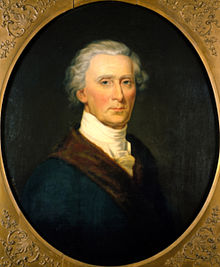
Back تشارلز كارول من كارولتون Arabic تشارلز كارول من كارولتون ARZ کارلس کارول کارلتون AZB Charles Carroll de Carrollton Catalan Charles Carroll Czech Charles Carroll German Charles Carroll de Carrollton Spanish کارلس کارول کارلتون Persian Charles Carroll Finnish Charles Carroll de Carrollton French
Charles Carroll | |
|---|---|
 Charles Carroll painted by Michael Laty | |
| United States Senator from Maryland | |
| In office March 4, 1789 – November 30, 1792 | |
| Preceded by | Office created |
| Succeeded by | Richard Potts |
| Delegate to the Second Continental Congress from Maryland | |
| In office 1776–1778 | |
| Member of the Maryland Senate | |
| In office 1781–1800 | |
| Personal details | |
| Born | September 19, 1737 Annapolis, Maryland, British America |
| Died | November 14, 1832 (aged 95) Baltimore, Maryland, U.S. |
| Nationality | Kingdom of Great Britain (1737–1776) United States (1776–1832) |
| Political party | Federalist[1] |
| Spouse | Mary Darnall |
| Relations | Charles Carroll of Annapolis (father) Charles Carroll the Settler (grandfather) Charles Carroll (cousin) Daniel Carroll (cousin) John Carroll (cousin) |
| Alma mater | College of St. Omer Lycée Louis-le-Grand |
| Signature | |
Charles Carroll (September 19, 1737 – November 14, 1832), known as Charles Carroll of Carrollton or Charles Carroll III,[2] was an American politician, planter, and signatory of the Declaration of Independence. He was the only Catholic signatory of the Declaration and the longest surviving, dying 56 years after its signing.[3]
Considered one of the Founding Fathers of the United States,[4] Carroll was known contemporaneously as the "First Citizen" of the American Colonies, a consequence of signing articles in the Maryland Gazette with that pen name.[5] He served as a delegate to the Continental Congress and Confederation Congress. Carroll later served as the first United States Senator for Maryland. Of all of the signers of the Declaration of Independence, Carroll was one of the wealthiest and most formally educated. A product of his 17-year Jesuit education in France, Carroll spoke five languages fluently.
Born in Annapolis, Maryland, Carroll inherited vast agricultural estates and was regarded as the wealthiest man in the American colonies when the American Revolution commenced in 1775. His personal fortune at this time was reputed to be 2,100,000 pounds sterling, the equivalent to £338,402,985 in 2023 (US$375 million). In addition, Carroll presided over his manor in Maryland, a 10,000-acre estate, and claimed as his property approximately 300 slaves. Though barred from holding office in Maryland because of his religion, Carroll emerged as a leader of the state's movement for independence. He was a delegate to the Annapolis Convention and was selected as a delegate to the Continental Congress in 1776. He was part of an unsuccessful diplomatic mission, which also included Benjamin Franklin and Samuel Chase, that Congress sent to Quebec in hopes of winning the support of French Canadians.
Carroll served in the Maryland Senate from 1781 to 1800. He was elected as one of Maryland's inaugural representatives in the United States Senate but resigned his seat in 1792 after Maryland passed a law barring individuals from simultaneously serving in both state and federal office. After retiring from public service, he helped establish the Baltimore and Ohio Railroad.
- ^ Ellis, John Tracy (1969). American Catholicism. Chicago: University of Chicago. p. 72. ISBN 978-0-226-20556-4.
- ^ "Signers of the Declaration: Biographical Sketches: Charles Carroll". National Park Service. Retrieved October 26, 2012.
- ^ "Charles Carroll, of Carrollton," The American Catholic Quarterly Review, Vol. XXIV, 1899.
- ^ Bernstein, Richard B. (2011) [2009]. "Appendix: The Founding Fathers: A Partial List". The Founding Fathers Reconsidered. New York: Oxford University Press. ISBN 978-0199832576.
- ^ "Charles Carroll Of Carrollton Commemorative Medal". State of Maryland. Retrieved March 10, 2021.